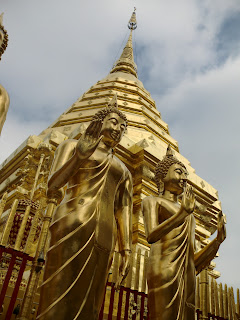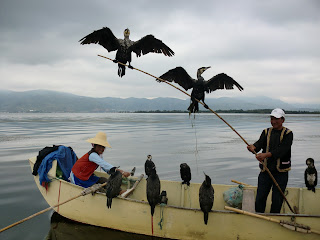Dalai and I
The moment we crossed the
border from Cambodia to Thailand we realised 2 things: the first, from now on
and for the rest of this leg we’ll be driving on the left side. Finally,
Boudicca is on the correct side of the road.
Yes dear Americans, Z
Jermans, froggies and any other anti-natural national drivers: you can argue as
much as you’d like that driving on the right is the correct way. But you’re
wrong. Save your words as it will never change the fact that keeping your right
hand on the steering wheel while the left hand is busy with the other necessary
activities while driving is just a lot safer. And we Overlanders want you to be
safe.
Face it, unless you’re
lefty (which, without discriminating, puts you in a very small group), you have
more control on your vehicle when your right hand is holding the steering wheel
while your left hand is busy changing a gear, a song, picking your nose, fishing
the tea bag out or just showing your middle finger to that idiot in the Toyota
Land Cruiser who just merged from the right without looking.
The reason some of you
still drive on the right is only a colonial slip-up. Keep your strong hand on
the wheel – drive on the left.
Anyway, the first thing
we realised when we crossed the border is that we are going to drive on the
left side again (and therefore that Thai people have more control on their
vehicle but really, let’s drop it now).
The second thing is that
we’re now back to ‘modernisation’: highways, facilities, 24/7 services and road
signs. A welcome change, we must admit, after long weeks of dirt roads, dust
and potholes.
We’re heading to Ko
Chang, a resort island south of Bangkok. It’s a small detour that we’re happy
to take to spend our last few days with Lady D, our wonderful companion since... well,
forever.
There’s not much to say
about Ko Chang, only that this is where Jen got ill with Dengue fever and that one
needs a lot of imagination to see that the island was once a beautiful piece of
earth. Now it’s an over-touristy place where one can shop for dead crocodiles’
skin, take pictures with exotic but chained sad-looking animals and party with
lady boys. Not our cup of tea, so we’re moving on.
Thailand is not exactly a
‘travelling’ destination. Everything is just too easy here. It is, however, a
great country for holidays, chilling out, culture and history activities and
for what westerners call ‘Thai Food’. Our next destination, we agree, should
combine it all.
 |
| chilling out |
At this point we decided
to continue with our motto: to have a number of dynamic options instead of a
firm plan. We love this motto; it keeps us open to any changes, moods and
improvisations on the road – I like to simply call it ‘freedom’.
One of our options was to
drive north, towards Ayutthaya. So we did.
The Thai roads would have
been excellent if they weren’t underwater. But they are. Another set of floods
hit Thailand a few weeks ago and large sections of the country are still a huge
bog.
These
recently-more-than-occasional floods are not a great surprise for a country
that used to be completely covered by a thick rainforest. Nowadays less and
less sections of the country are still forested and with no trees to take the
monsoon rain... you get the picture: the locals do.
The signs of flooded plains
are quite surreal: murky water all around, islands of debris and rivers running
through houses and abandoned shops. People with their few belongings are
crowded in improvised shelters on the side of the highway or on roofs, sitting
anywhere that is still above the water level – for weeks.
We’re counting another
Environment Disaster, # 4391 on this journey alone.

 |
| Floods in Thailand |

Ayutthaya, the ancient capital of Siam, is still a marshland. The local government thought it’s better to keep this World Heritage Site swamped as part of their strategy to save the industrial district of Bangkok. Money talks – the rest sinks. So we take a tour in a World Heritage Site underwater and actually, were quite enjoying it.
We’re the first tourists
in town since the flooding and locals are happy to have us. We get special
treatment everywhere, Lady D is spending her last Bahts on massages and Jen is
recovering well from the fever. With high moral and wet feet we kiss D for
goodbye for now and continue north, to Chiang Mai.
It’s great to be in
Chiang Mai again. It’s a city of contradictions: street stalls next to healthy
food restaurant, ugly local girls hung around with fat old Europeans, Yoga
studios located above polluted noisy streets and golden temples are a safe home
for a pack of bad looking dogs. It’s a city where the old market, selling
traditional hill tribes artefacts, attracts more human traffic than the air
conned, shiny shopping malls with its fashionable items from London and Rome. I
like Chiang Mai.
 |
| Chiang Mai |
But I feel like it’s time
to do something different – something with a distinctive character, low paced
but high well being. Low key but high note. Maybe feed my spiritualism a
little.
I’m turning to my old
dear buddy – Google. Quick search. Finding a Buddhist temple in the forest up
on the mountain – just outside the city. Reading. Monks came down from the
remote mountains of Burma are now teaching how to meditate.
Interesting –reading on.
The programme: 7 days,
all inclusive – meditation lessons, introduction to Buddhism, accommodation,
breakfast, lunch. ...And dinner? No. Buddhist monks don’t eat after midday. No dinner,
no teatime, no afternoon snack, no supper and definitely no midnight munch.
Mmm... a problem. I have superfast metabolism, so I must feed the monster every
4 hours. ...At least. Will I survive?
I’m thinking about this
again: a chance for starvation - but - a
temple on the mountain with Monks meditating all day; definitely low paced,
surely some potential to increase my well being and no question about feeding
my spiritualism there. So I’m booking the meditation. Que Serra.
Pack a rucksack, down 7
breakfasts, put on pure white clothes and head up to the mountain and the
temple. Driving to a meditation retreat in a Land Rover Discovery – irony.
I’m in the temple.
Tropical greenery. Birds’ song in the air. Incense aroma. I like. And here’s a
young woman, down the footpath, sitting, relaxed, eyes close, focused. So this
is meditation. Right. I could do this.
Welcome ceremony. I’m
meeting my teacher monk. He looks like a slightly younger Dalai Lama. Smiling,
he’s telling me about the principle of meditation, the technique and the
timetable for the next week.
Outline of the principle:
generally, to reach nirvana. More practically, to reach inner peace,
mindfulness and silence the mind. Important things indeed.
The technique: Stop the
‘thinking-thinking’ action and focus on breathing only; raising-falling. 15
minutes walking meditation, 15 minutes sitting meditation, 15 minutes break and
repeat. Cool, so when’s food time here..?
Timetable: wakeup at 5am
and the rest I didn’t hear. 5am?! Ok... I really need to kill Que Serra one
day. There are also Dhamma lessons, chanting, monks chat, lots of meditation
and absolutely confirmed and double-checked: no dinner. 5am...
First lesson: sitting in
the lotus posture. Stopping the ‘thinking-thinking’ action. Focusing on breath.
Raising-falling....
I’m failing immediately.
Millions of thoughts are running through my head. Starting again. Sitting.
Stopping ‘thinking-thinking’
... thinking about the
Land Rover, pizza and that lady on the footpath. Not good. Trying again. And
again. I am now discovering how difficult it is to stop thinking. Impossible.
Where’s that Dalai Lama chap, I need to figure out how it’s done.
I can’t turn my brain off
– I tell him. He’s laughing. You cannot turn the brain off on your first day of
meditation. Meditation takes a long time and plenty of determination. You
should start by first ‘acknowledging’ the thought when it comes in and then
‘put it away’.
Ok, thanks Dalai.
Back to my pillow.
Sitting. Practicing. Again and again. I skip the other activities. Concentrating.
Raising-falling.
Evening. I’m entering my
room, sitting on the bed. Raising-falling. Thought. Acknowledge, Put aside.
Raising-falling.
Raising-falling...
Night. Exhausted. Hungry.
Closing my eyes and without thinking on a thing – I’m falling asleep.
Early morning. Sleepy.
Starving. Breakfast. A plate of rice. Not enough for me. I’m sneaking into the
kitchen, spotting the pot and loading 3 more plates of rice. Much better. Back
on the pillow again, raising-falling. Thought. Acknowledge, put aside.
Raising-falling.
Raising-falling...
Raising-falling...
 |
| Dalai in Dhama (5am...) |
*
Raising-falling...
All of a sudden it’s the
last day of the retreat. I jump out of bed. I’m awake and relaxed. I’m eating
my single plate of rice slowly and peacefully. Finally – quiet. I’m saying
goodbye to my teacher monk. Don’t forget the balance, the centre and stay
mindful – he’s advising as I leave the temple. I won’t forget.
I’m driving down the
mountain and back to the valley. In Chiang Mai again. Hordes of tourists,
crowded streets, busy traffic, street stalls... I acknowledge, put aside and stay
mindful. Raising-falling. Haaa...And it’s all quiet again.
Thank you, Dalai.
Jen & Noam
More photos, stories and action in our website











































